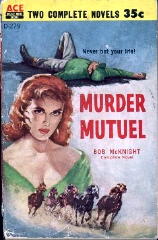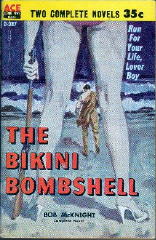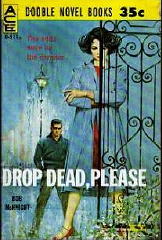December 2008
Monthly Archive
Fri 12 Dec 2008
Posted by Steve under
Authors ,
Reviews1 Comment
RICHARD S. PRATHER – Over Her Dear Body.
Gold Medal s887; paperback original. First printing, June 1959. Reprinted many times.
[As a brief preface, this is the book I read immediately following Hyde and Seek, by Benjamin Wolff, and reviewed here by me earlier on the blog.]
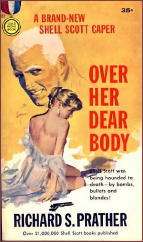
Two books in a row, and in both a private eye (or someone playing at being a private eye) is hired by a girl (a knockout, of course) to help her brother, who has been working at some secret deals, making a lot of money, then either (1) disappearing, or (2) starting to worry for his life.
Coincidences happen, but it’s still a little scary.
Actually all it really says is that there is a shortage of private eye plots to go around. So, I thought, we’ll let the veteran Mr. Prather show the new guy how it’s done. After all, hadn’t he already sold over 21,000,000 Shell Scott books by the time this was published? (Information taken at face value from the front cover.)
Isn’t he the guy with the built-in leer in his typewriter? Books full of tomatoes, bikinis, nudist camps and other highly unlikely spots for one of the toughest private eyes in the business to find business in? (Information from reading but a small fraction of the above-mentioned 21,000,000 books — which is all it takes. Really.)
Unfortunately and in all honesty, this wasn’t one of Mr. Prather’s better efforts. There are no drug smugglers, no South American generals, no semi-benevolent order of Christian missionaries — only a single gang of crooks whose only task is to wipe out Shell Scott before he wanders onto the truth. And of course they don’t. End of story.
If the plot of Hyde and Seek ended up far too complicated — and with too many loose ends — to be believable, not to mention sour-tasting (or maybe I did — say something along those lines, I mean), the trail Shell Scott follows in this book is as straight as a string.
The tomatoes are delicious, though.
— From Mystery.File 1, January 1987 (slightly revised).
[UPDATE] 12-12-08. The following paragraph, again only slightly revised, was actually the first paragraph of the next review to appear in that issue of Mystery.File 1. As you can see, reviewer’s remorse was already setting in:
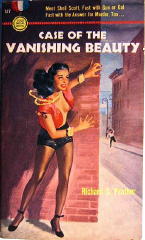
“Lest you misunderstood, let me hasten to add that I found the Prather book easier — more fun — to read than the one by Wolff. In spite of a simplistic plot and some rather obvious padding, Prather knows how not to take himself too seriously, and how to entice the reader into keeping the pages turning. After all, 21 million books cannot be wrong.”
And keep in mind that the cover blurb where I found that figure was from a book published in 1959. Prather’s career continued with Gold Medal up to 1964 when he switched to Pocket, where he stayed until 1975. Two further books came out from Tor in 1985-86, both Shell Scott books, but by that time interest in wacky PI novels had diminished greatly, and neither of them seemed to attract much notice.
I’ll refer you to the Thrilling Detective website for more on both Shell Scott and his creator, Richard S. Prather, along with a complete bibliography and a small selection of covers. And if you want even more, here it is: http://user.dtcc.edu/~dean/.
Thu 11 Dec 2008
THE FRIENDS OF EDDIE COYLE. Paramount, 1973. Robert Mitchum, Peter Boyle, Richard Jordan, Steven Keats, Alex Rocco, Joe Santos. Based on the novel by George V. Higgins. Screenwriter/director: Peter Yates.
My wife and I upgraded our cable boxes last month, two of them, and part of the package (at an additional ten dollars a month) were all of the Cinemax channels, while the HBO ones came free, if you don’t include the cost of the high-definition box we converted to downstairs.

You don’t need to know all of this, but as far as I am concerned the extra $10 Cimemax surcharge was paid for in one swoop, when I taped this movie late one night last week. For some reason — no one seems to know why — The Friends of Eddie Coyle has never been released commercially, on either video or DVD, but right now it’s strong in the running as the best Robert Mitchum movie I’ve ever seen.
And that’s saying some, as Robert Mitchum has always been one of my favorite movie actors, bar almost none. His sleepy-eyed facade belies some of the most complex and interesting characters ever portrayed on film. I don’t know if he and I would get along in person, but on the screen, he’s a giant, as far as I’m concerned.
Until yesterday, I’d have said that Farewell My Lovely, which came a couple of years later and was the first time around that he played Philip Marlowe, was my favorite Mitchum role, but no more. (Of course, if I were see Farewell, My Lovely again right now, I might change my mind.)
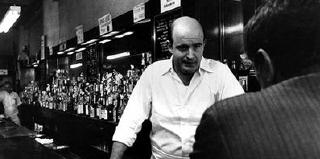
As usual, I’ve not read the book that The Friends of Eddie Coyle is based on, so I’m not reviewing that, only the movie. It takes place in and around Boston, where Eddie Coyle (that’s Mitchum) is doing the best he can to stay out of jail for a job he did, got caught for, didn’t rat out on the guy who hired him, but is thinking of making a deal with the Feds (Ã la Richard Jordan) on some of the other criminal activities going on that he knows about, including a gang of professional robbers hitting suburban banks.
Obviously — isn’t it? — the title of the movie is a misnomer. Eddie Coyle has no friends. The life of a criminal is hard. You get old, and even if you don’t, you never know whom to trust, not even the guys you’ve always though were your best pals. Eddie Coyle is tough but wearing out.
If you thought that noir movies were never made after 1960 or that noir movies could never be made in color, you’d be wrong on both counts. The bright brisk color of Boston and environs in the late autumn are in a not-so-subtle contrast with the quiet desperate of Eddie and his acquaintances as they try to scrap up a buck here and there, and the dingy bars, diners, bowling alleys and shopping malls where they transact most of their business.
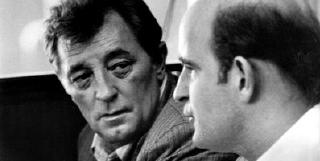
I’ve looked but I’ve not come up with scenes from the movie that are in color. Black and white will have to do. It’s appropriate enough, but if you see the film, you have to see it in color. The movie exists, but you’ll have to do some scrambling around to get it.
And when you do, don’t be distracted and put off by the lack of straightforward storytelling. You’ll see for a while what seems to be two movies going on at the same time and in the same place, switching back and forth from one to the other, small snippets of Eddie’s life here, the gang of bank robbers pulling off their jobs there, and in between Stephen Keats as Jackie Brown, plying his trade as a young but experienced dealer in illegal guns (or so he thinks).
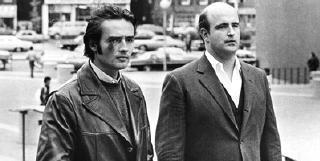
I didn’t mention any women in the credits I listed up above. There are none. None that have more than three minutes on the screen. This is a man’s movie, and while women are in the film, they have no say in what happens. Not that the men in it have much say, either.
Have I gotten you interested but not convinced? Here’s a link to a three-minute trailer for the film: https://www.youtube.com/watch?v=_WtR-mi6VtU. That ought to do it …
… but if not, watch this: https://www.youtube.com/watch?v=MR-_m4CLzM8&feature=related.
Perfect!
Thu 11 Dec 2008
BENJAMIN WOLFF – Hyde and Seek.
Avon, paperback original; 1st printing, October 1984.
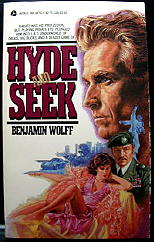
A blurb from Tony Hillerman is on the back cover, and he makes the book sound promising, if not more so: “A great story, a skillful storyteller … action-suspense fans are going to love this one.”
I hate to disagreed with Mr. Hillerman, but I do. I thought the story was murkily plotted, that Wolff is an unpolished story-teller, and that while I personally didn’t go wild over it, maybe the book did sell well in army post bookstores. Not that it’s in Donald Pendleton’s league, but when it comes down to it, whose are?
From the publicity blurb on the front cover, I was also led to believe that this was a private eye yarn. As it turns out, though, the only real connection the protagonist of the story, John Byron Hyde, has with that profession is through a part-time job he has doing an insurance investigator’s books.
He is also a part-time karate instructor, however, and a disillusioned post-traumatized Vietnam vet, and (after some thought) nobody I’d really rather care to know. (There goes the rooting interest.) When he’s asked by a girl (a knockout, of course) to help her find her brother, who’s mysteriously disappeared, he ends up in a sour-tasting melange of drug smuggling, South American politics, and the semi-benevolent order of The Good Helpers of our Lady The Mother of God.
After something of a conclusion has taken place (at least everybody’s motivations are laid out in the open), the story is clearly continued into the next volume of Mr. Hyde’s adventures. I have a copy — it’s here somewhere– but if/when I find it, the question is, will I read it? You have two guesses, the same as I, and the second doesn’t count.
— From Mystery.File 1, January 1987 (revised).
[UPDATE] 12-11-08. An uneasiness I have whenever I pull a review out of my archives that’s as negative as this one is that it turns out to have been written by someone I know, but writing under a pen name at the time. Not that I fear writing negative reviews (not all books can be as wonderful as the publicity guys make them sound), but generally speaking, I tend not to write reviews of books by authors I know.
It turns out that Wolff was a pen name, and that there were only two of John Hyde’s adventures. My review had nothing to do with the latter. No more than 40 people may have seen this review when it first appeared; more than likely it was only a tenth of that.
From the Revised Crime Fiction IV by Allen J. Hubin:
WOLFF, BENJAMIN. Pseudonym of Louis Chunovic; see also Charles Heath.
Hyde and Seek (Avon, 1984, pb) [John Byron Hyde; Los Angeles, CA]
Hyde in Deep Cover (Avon, 1985, pb) [John Byron Hyde; Bolivia]
Nasty Boys (Berkley, 1991, pb) [Las Vegas, NV]
HEATH, CHARLES. Generally a pseudonym of Ron Renauld, but also note the book below:
Operation Desert Sun: The Untold Story [by Louis Chunovic] (Dell, 1984, pb) [A-Team; Middle East]. Novelization of the “A-Team” TV series.
Thu 11 Dec 2008
NORA ROBERTS – Midnight Bayou.
Jove; paperback reprint; first printing, December 2002. Hardcover edition: Putnam, October 2001.
I may or may not have mentioned this recently, but among other things, I collect gothic paperback romances. In the decade from roughly 1965 to 1975, they were immensely popular, with a thousand or more different titles published. Every publisher did several a month, or so it seemed, and readers must have gobbled them down like candy.
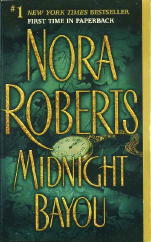
Eventually historical romances took over, “bodice-rippers” as they were called for a long time, and the gothics died away, never quite completely, but never again to make a sustained comeback. (Novels of romantic suspense — heroines in jeopardy — are still with us, and seem to be rising in popularity, but without the overtones of the weird and occult, most of them cannot be properly called gothics.)
Some books hover right on the borderline, and this latest romantic novel from Nora Roberts is one of them. The prologue certainly has all of the right elements, beginning with the rape and murder of a young woman by her husband’s twin brother in Louisiana’s turn-of-last century’s bayou country. Her young daughter is left alive, but abandoned to her mother’s backwoods family, she’s forcibly separated from her father’s heritage, rightfully hers.
It’s a strong, intense start, and the ghosts of the past that still haunt Manet Hall in the year 2002 are what keeps the book loosely in the gothic genre. But it’s largely the story of two modern-day lovers, Boston raised-and-born Declan Fitzgerald, Manet Hall’s new owner, determined to refurbish it, and Angelina Simone, Cajun descendant of the young murdered woman and her infant daughter.
Nora Roberts writes romance (if not sublimated lust) that simply oozes with electric tension on the printed page, with dialogue that continually crackles with chemistry and wit. It’s hard to imagine more perfect people than Declan and Angelina; even their flaws are perfect. This is the stuff of fantasy.
As for the ghost story, it’s chilling at first, but it fades in significance in comparison with Declan’s efforts to persuade Angelina that he’s the man for her, then it collapses altogether with no logic behind which spirit is doing what and for what reason.
Well, most of the old-fashioned gothics ended in much the same way, the hints of mysticism waved away, and wedding bells in the offing. Nora Roberts just may have you believing it all, however, especially during the telling. It’s no wonder she’s one of the most popular authors writing today.
— December 2002 (slightly revised)
[UPDATE] 12-11-08. And of course she still is today, and if possible, even more so. Quoting from her Wikipedia entry:
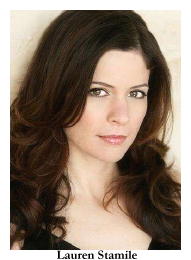
“Nora Roberts was the first author to be inducted into the Romance Writers of America Hall of Fame. As of 2006, her novels had spent a combined 660 weeks on the New York Times Bestseller List, including 100 weeks in the number-one spot. Over 280 million copies of her books are in print, including 12 million copies sold in 2005 alone. Her novels have been published in 35 countries.”
The best bibliography, with the most covers, is as usual at the UK FantasticFiction website. Go and prepare to be amazed. (But not if the numbers in the previous paragraph have sunk in.)
Also, from HollywoodReporter.com: “October 27, 2008. Lifetime has lined up big-name talent for the first two of its four upcoming movie adaptations of Nora Roberts novels. […] Jerry O’Connell, Lauren Stamile and Faye Dunaway lead the cast of Midnight Bayou.”
It looks like perfect casting to me.
Wed 10 Dec 2008
TALMAGE POWELL – Man-Killer.
Ace Double D-469; paperback original. First printing, 1960.
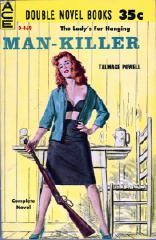
Speaking of “workmanlike prose,” as I was a little while ago — in the review of the other half of this Ace Double, as a matter of fact — I know Talmage Powell wrote a good deal for the pulps, so I’m not surprised to find anything he wrote totally readable — even, to coin a phrase, “hillbilly mystery fiction,” of which this might be a prime example (complete with moonshiners, deputy sheriffs and other dumb hicks).
[The other half was Bob McKnight’s Running Scared, and you can find my comments here.]
If a lack of tightly knit plotting may have been McKnight’s Achilles heel in the other half of the double volume, then a tendency toward melodramatic dialogue is Powell’s in his portion. Or maybe I’m not the one to judge. Perhaps old aristocratic ladies now on hard times actually speak the way they do in this book while contemplating their future — and the future of wayward sons who (in this book) insist on helping a poor hill girl accused of killing her husband days before her divorce becomes final.
Or maybe the subject matter just naturally leads toward melodrama. More solidly plotted than McKnight’s book, Man-Killer nonetheless lacks the compulsive (not to say screwy) readability of Running Scared, which, on the whole, if you were to ask, I’ve decided is the better of the two.
— From Mystery.File 1, January 1987 (heavily revised).
[UPDATE] Later the same day. I didn’t do it ahead of time, and maybe I should have, but in the first comment to this post, August West happened to mention Talmage Powell’s private eye character Ed Rivers. Having a few minutes on my hands, I followed up with a list of all five detective novels that he was in. Check it out.
Tue 9 Dec 2008
THE PERILS OF NYOKA. Aka Nyoka and the Tigermen. Republic Pictures, 1942. 15-part serial. Kay Aldridge, Clayton Moore, Lorna Gray, Charles Middleton, William Benedict, Forbes Murray, George Pembroke, Tristram Coffin, Robert Strange. Director: William Witney.
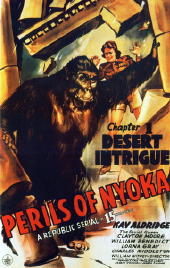
The plot is simple enough. In exchange for helping a small group of scientists and archaeologists find the long lost Tablets of Hippocrates, rumored to provide the location of a hidden treasure of gold and jewels, Nyoka Gordon requests their help in finding her father, equally long lost in the same area of northern Africa as the Tablets.
Some observations follow, pretty much as they come to me.
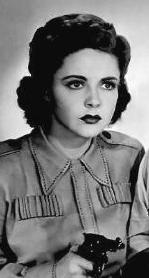
? Kay Aldridge plays Nyoka as a fresh-faced debutante straight out of finishing school with a formal accent that is hard to describe, but in essence it sounds something like this: “I need your help in finding my fah-tha.”
â— But no ordinary debutante is she. Living in Africa as her home, she has probably never even gone to a ball, or dressed formally. Shirt and shorts are her everyday attire. It is she, of course, who gets into a serious scrape at the end of every chapter.
â— By “serious” I mean deadly. Going over a cliff in a chariot, lying on a sacrificial altar while a swinging blade gets closer and closer, being blown out of a wind tunnel built into the side of a cliff, and picking herself up and dusting herself off for the next step of the adventure.
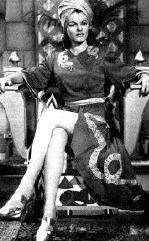
â— The cliffhanger endings — and resolutions — are very well done. I thought the wind tunnel gag was questionable, but I never went back to check it out. The rest? Very smooth indeed.
â— Playing Vultura, the ruler of the natives who also would like her hands on the treasure, is Lorna Gray. Mostly she wear long slit skirts, but whenever the slit widens we see more of her legs, long and beautiful, than we do of Nyoka’s.
â— It was my friend Jim Goodrich who suggested that I watch this serial. The primary reason was to see Lorna Gray. He remembers that as a 15-year-old (or so) all of his fellow buddies came out of the theater with their tongues hanging out after seeing Lorna Gray as Vultura.
â— I am paraphrasing Jim’s actual words. His description was much more vivid. And accurate. And more couth, too.
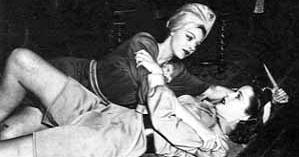
â— Both Nyoka and Vultura are more than willing to mix it up personally with the members of the other side, and with each other, providing for many highlights on ESPN later, if ESPN had been around in 1942.
â— Nyoka in particular has no compunction against slugging away with her fists at the men with flowing robes who are in her way. Nor leaping nor climbing nor jumping. A real heroine.
â— Mentioning flowing (Arab) robes reminds me that there is little other way to grasp the fact that the story is taking place in Africa. Otherwise the hills where all the action takes place look very much like the hills where many a B-western was shot. (As far as actual locations, IMDB says they included the Corrigan Ranch in Simi Valley and the Iverson Ranch in Los Angeles.)
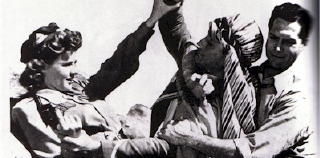
â— Guys in long flowing robes have a big handicap fighting hand-to-hand against guys who don’t.
â— In the early going I thought the star of the movie was the guy in the ape suit. He disappeared for a while, then had a big role again at the end.
â— I watched an episode a night for 12 chapters, missed a night, then made up for it by watching the last three in on big gulp. Couldn’t resist.

â— When Nyoka’s father is found, he has been the chief of the Tuaregs for some time with no memory of a previous life. To bring his memory back, Dr. Larry Grayson (Clayton Moore) has to take 10 minutes off from helping Nyoka get in and out of her perils to operate on him, in order to relieve the pressure of his skull against his brain. While a huge fight is going on in the next cave.
â— Professor Gordon has what might be called an instant recovery from this rather makeshift bout of brain surgery. He is up and about immediately, with no bandages around his head to indicate anything was ever amiss. And he almost goes out the wind tunnel with Nyoka for all his resilient strength and recuperative ability.
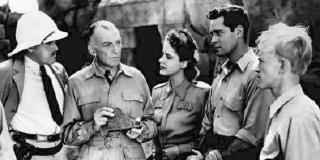
â— I saw Jay Silverheels in the list of miscellaneous cast members. This was before he joined up with Clayton Moore as that other pair of characters that you may remember them as.
â— I may have seen this serial myself, not in 1942, but in 1952, when it was re-released. I would have been ten. I’m not sure, but the guy in the ape suit certainly looked familiar. And by the way, that alternate title? Not a single tiger in this movie. It has almost everything else, but no tigers.
Tue 9 Dec 2008
BOB McKNIGHT – Running Scared.
Ace Double D-469; paperback original; 1st printing, 1960.
I meant to say something about George Harmon Coxe’s “workmanlike” prose in my recent review of Murder for Two, but it could be said just about as well right here. [The phrase is a common one; Google just a moment ago produced about 3000 hits.] What I mean by the term is this: a style of writing that you just don’t notice.
Nothing so fancy as to call attention to itself, although as a standard that’s hardly enough. It can’t be anything other than a subjective assessment, one that varies from person to person.
Nonetheless, assuming that there is such a concept, I think that “workmanlike prose” was more common with writers whose background was working for the pulp magazines. Writers whose job it was to tell a story, to get on with it, before their readers got bored and went on to something else.
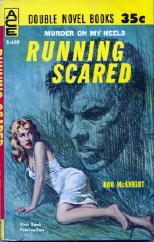
Coxe was such a writer. Frank Gruber was another. The most famous was probably Erle Stanley Gardner. None would get much of notice for their writing from a professor of literature, but because they were good writers, they captured the reader’s attention from page one onward.
Although I don’t believe he ever wrote for the pulps. He came along a little too late for that. He was a paperback writer. He never had a book come out in hardcover, so in the overall scheme of things he’s on a far lower scale than either a Gardner or a Coxe, who both made it big. But a storyteller? Yes.
The plot of Running Scared is that of your basic, everyday nitwit hero in a not quite everyday basic situation. He’s the kind of guy who has reasons for not calling the cops on page two — for if he had, there would be no story. He watches a murder take place, committed by someone driving his ex-wife’s car, and then he gets a call warning him that she has reported the car stolen. By him.
He goes to her apartment (after being beaten up by two hoods on the way), befriends another girl there, hides her in a bathroom hamper when the cops come calling, and then finds her shot to death inside the hamper when the cops leave.
I am not making this up. Actually, it reads very well. McKnight had the knack of making you believe nonsense like this all the while you realize that it is nonsense. Workmanlike prose, remember? One could easily picture an Alan Ladd or a Dick Powell in the leading role.
But in the end, this is about all there is to say about the book. The pace is terrific, and I guarantee you that once stated, you will keep reading. Unfortunately, I cannot tell you that there is any overall depth to either the characters or the story. It’s too lightweight to be considered memorable, and the non-meticulous details of the plot are exactly that.
What Running Scared is, though, is fun to read.
— From Mystery.File 1, January 1987 (heavily revised).

[UPDATE] 12-09-08. My comments on the other half of this Ace Double will be posted here shortly. For the record, it is Man-Killer, by Talmage Powell, an author who really did start out writing for the pulp magazines before shifting into a career, mystery-wise, of mostly paperback originals.
As for Bob McKnight, here below is a complete list of his novel-length mystery fiction, as compiled in the Revised Crime Fiction IV, by Allen J. Hubin. Surprisingly enough to me, when I wrote this review I obviously didn’t recognize PI Nathan Hawk as being in this book and as being a series character. I thought so little of him, apparently, that I didn’t even mention his name. (I don’t think he was the main protagonist, but perhaps he was.)
[INSERTED LATER.] I have located my copy of Ace Double D-469, and I was “right” and Al has erred in including Nathan Hawk as a Series Character in
Running Scared. The primary protagonist is a guy named Harlan Jamieson and no PI’s are in the picture at all. I’ve so informed Al, and the deletion of Mr. Hawk from this book will be so mentioned in the next installment of the
online Addenda. Also added will be the setting: St. Petersburg, Florida, so established by the mention of Al Lang Field early on in the story.
And as long as I’ve brought him up, Nathan Hawk is included in Kevin Burton Smith’s website devoted to Private Eye fiction. He says, in part: “Tough guy eye NATHAN HAWK, transplanted northerner in Sun City, Florida, shot and slugged his way through ten novels published by ACE in the late fifties and early sixties. Detective Lieutenant Toby Duane lends a hand when he can, and dishes out plenty of friendly ‘damn yankee’ jibes along the way.”
Running Scared is the only one of McKnight’s books I’ve ever read. Even though my judgment was qualified, I’m a sucker for books with wacky openings like this, even if the endings don’t pan out so well in comparison. Given an opportunity, I absolutely would read another.
McKNIGHT, BOB. 1906-1981. Mining engineer, pilot and horse-racing handicapper before semi-retiring to Florida.
Downwind (n.) Ace Double D-217, 1957 [Santa Fe, NM]
Murder Mutuel (n.) Ace Double D-279, 1958 [Nathan Hawk; Florida]
The Bikini Bombshell (n.) Ace Double D-387, 1959 [Nathan Hawk; Florida]
Swamp Sanctuary (n.) Ace Double D-411, 1959 [Florida]
Kiss the Babe Goodbye (n.) Ace Double D-447, 1960 [Nathan Hawk; Florida]
Running Scared (n.) Ace Double D-469, 1960 [DELETE Nathan Hawk; ADD setting: Florida (St. Petersburg)]
Secret Sinners (n.) Merit 35, 1960 [Nathan Hawk; Florida]
A Slice of Death (n.) Ace Double D-419, 1960 [Florida]
Drop Dead, Please (n.) Ace Double D-511, 1961 [Florida]
The Flying Eye (n.) Ace Double F-102, 1961 [Florida]
A Stone Around Her Neck (n.) Ace Double F-143, 1962 [Nathan Hawk; Florida]
Homicide Handicap (n.) Ace Double F-229, 1963 [Nathan Hawk; Florida]
Tue 9 Dec 2008
GRAHAM THOMAS – Malice Downstream.
Fawcett Books; paperback original; 1st printing, December 2002.

Graham Thomas is a Canadian writer (British Columbia) who seems to have the British down pat, both the countryside and the countrymen. This is the fifth case for Detective-Chief Superintendent Erskine Powell, all paperback originals, and in the age of bloated mysteries running up to 400 pages or more, they’re lean and mean at a mere 200 plus.
In Malice Downstream Powell is found recuperating from a previous injury at a small village called Houghton Bridge, known almost only for its superb chalk stream fishing, and home of the renown Mayfly Club. Taking his mind off his almost healed leg, and to a lesser extent his failing marriage, Powell also finds murder, with roots in the past. Totally out-of-bounds in taking a hand in investigating a case he shouldn’t be, he’s obviously the epitome of a busman on holiday.
The detective work is solid if not flashy, with a villain rather obvious from first meeting, but if fly-fishing is an art you’re interested in, this is the book for you. And even if you’re not, if you can enjoy reading about the enthusiasm that someone else has for their near-obsessive hobbies, then this is also the book for you.
Overall a male-oriented book, but still very cozy in nature. Snug and insightful, in a minor key sort of way.
— December 2002 (slightly revised)
[UPDATE] 12-09-08. Until I looked him up in the Revised Crime Fiction IV, by Allen J. Hubin, I did not know that Graham Thomas was a pen name, but it is so. I’m guessing, of course, but perhaps Kosakoski did not sound “British” enough to someone whose opinion mattered.
Using his entry in CFIV as a basis, here below is a complete list of the Graham Thomas mysteries. Chief Supt. Erskine Powell is in all of them.
Note: In the original version of this review, I stated that Malice Downstream was the sixth in the series. It does not appear to be so, nor was there ever a sixth.
THOMAS, GRAHAM. Pseudonym of Gordon Kosakoski, 1950- .
Malice in the Highlands. Ivy, pbo, Jan 1998.
Malice in Cornwall. Ivy, pbo, June 1998.
Malice on the Moors. Ivy, pbo, Aug 1999.
Malice in London. Ivy, pbo, April 2000.
Malice Downstream. Fawcett, pbo, Dec 2002.
Mon 8 Dec 2008
Note that the movies listed below, each based on an Agatha Christie novel or short story, are only those which are not included in the original Crime Fiction IV, by Allen J. Hubin. (They are included in the Revised CFIV, but not in this expanded version, as well as the online Addenda, where they also are.)
For more information on each of the movies or TV series episodes mentioned, follow the links provided to their corresponding IMDB entries.
CHRISTIE, AGATHA
● After the Funeral. TV movie [series episode]: Granada, 2005 (scw: Philomena McDonagh; dir: Maurice Phillips. SC: Hercule Poirot (David Suchet)
● At Bertram’s Hotel. TV movie : BBC/PBS, 1987 (scw: Jill Hyem; dir: Mary McMurray) . SC: Miss Jane Marple (Joan Hickson)
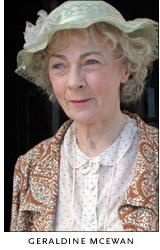
● The Body in the Library. TV movie: BBC/PBS, 1984 (scw: T. R. Bowen; dir: Silvio Marizzano). SC: Miss Jane Marple (Joan Hickson). Also: Granada, 2004 (scw: Kevin Elyot; dir: Andy Wilson). SC: Miss Jane Marple (Geraldine McEwan)
● By the Pricking of My Thumbs. TV movie: Granada, 2006 (scw: Peter Medak; dir: Stuart Harcourt). SC: Miss Jane Marple (Geraldine McEwan), Tuppence & Tommy Beresford (Greta Scacchi & Anthony Andrews ). [Miss Marple did not appear in the book version.]
● Cards on the Table. TV movie [series episode]: Granada, 2005 (scw: Nick Dear; dir: Sarah Harding). SC: Hercule Poirot (David Suchet) [and Zoë Wanamaker as Ariadne Oliver]
● A Caribbean Mystery. TV movie: Stan Margulies, 1983 (scw: Sue Grafton, Steve Humphrey; dir: Robert Michael Lewis). SC: Miss Jane Marple (Helen Hayes). Also: BBC, 1989 (scw: T. R. Bowen; dir: Christopher Pitt). SC: Miss Jane Marple (Joan Hickson)
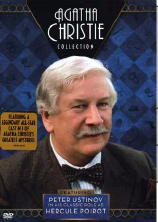
● Dead Man’s Folly. TV movie: CBS, 1986 (scw: Rod Browning; dir: Clive Donner). SC: Hercule Poirot (Peter Ustinov) [and Jean Simmons as Adriadne Oliver]
● Death on the Nile. TV movie: London Weekend/A&E, 2004 (scw: Kevin Elyot; dir: Andy Wilson). SC: Hercule Poirot (David Suchet)
● Dumb Witness. [Published in the US as Poirot Loses a Client.] TV movie [series episode]: London Weekend, 1996 (scw: Douglas Wilkinson; dir: Edward Bennett). SC: Hercule Poirot (David Suchet)
● Evil Under the Sun. TV movie [series episode]: London Weekend, 2001 (scw: Anthony Horowitz; dir: Brian Farnham). SC: Hercule Poirot (David Suchet)
● Five Little Pigs. [Published in the US as Murder in Retrospect.] TV movie [series episode]: London Weekend, 2003 (scw: Kevin Elyot; dir: Paul Unwin). SC: Hercule Poirot (David Suchet)
● 4:50 from Paddington. [Published in the US as What Mrs. McGillicuddy Saw!] TV movie: BBC/A&E, 1987 (scw: T. R. Bowen; dir: Martyn Friend). SC: Miss Jane Marple (Joan Hickson). Also: Granada, 2004 (scw: Stephen Churchett; dir: Andy Wilson). SC: Miss Jane Marple (Geraldine McEwan)
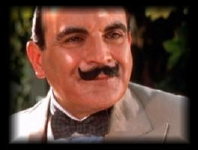
● Hercule Poirot’s Christmas. [Published in the US as Murder for Christmas.] TV movie [series episode]: London Weekend/PBS, 1994 (scw: Clive Exton; dir: Edward Bennett). SC: Hercule Poirot (David Suchet)
● Hickory Dickory Dock. TV movie [series episode]: London Weekend, 1995 (scw: Anthony Horowitz; dir: Andrew Grieve). SC: Hercule Poirot (David Suchet)
● The Hollow. TV movie [series episode]: Granada/A&E, 2004 (scw: Nick Dear; dir: Simon Langton). SC: Hercule Poirot (David Suchet)
● The Hound of Death and other stories. TV movie The Last Seance, based on ss in this collection: Granada, 1986 (scw: Alfred Shaughnessy; dir: June Wyndham-Davies)
● Lord Edgware Dies. TV movie: CBS, 1985, as Thirteen at Dinner (scw: Rod Browning; dir: Lou Antonio). SC: Hercule Poirot (Peter Ustinov). Also: Carnival/A&E, 2000, as Lord Edgware Dies (scw: Anthony Horowitz; dir: Brian Farnham). SC: Hercule Poirot (David Suchet)
Mon 8 Dec 2008
REVIEWED BY JOHN APOSTOLOU:
DRESSED TO KILL. Fox Film Corporation, 1928. Irving Cummings, director; Edmund Lowe, Mary Astor, Ben Bard, Robert Perry, Joe Brown, Tom Dugan, John Kelly, Robert Emmet O’Connor, Ed Brady, Charles Morton. Shown at Cinecon 41, September 2005.
This silent movie bears no relationship to any of the three films released between 1941 and 1980 that have the same title. This Dressed to Kill is what we used to call “a cops & robbers movie.” The stars are Edmund Lowe and Mary Astor (whom we all remember for her role in The Maltese Falcon).
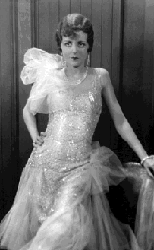
Lowe’s character is the boss of a gang that specializes in big heists, and Astor plays an attractive young woman who becomes his girlfriend. On the night of a robbery, the gang dresses in formal clothes, pretending to be a group of wealthy gentlemen going out on the town.
When they arrive at the site of the robbery, they change into their regular duds, and when making their getaway they again put on their formal clothes. I suppose this explains the meaning of the title.
A mystery element enters the plot when Astor’s character becomes Lowe’s girlfriend (read mistress). We wonder why such a smart young lady would get involved with gangsters. Is she working for the police? Or is she just a pretty gal who’s seeking a fast, glamourous life?
Dressed to Kill is well directed by Irving Cummings. Lowe and Astor give good performances. The photography has a noirish look, and the sets and costumes nicely represent the art deco era. Although not a masterpiece, certainly not in the same class as von Sternberg’s 1927 Underworld, the film is very entertaining and would certainly please silent movie buffs.
« Previous Page — Next Page »

















